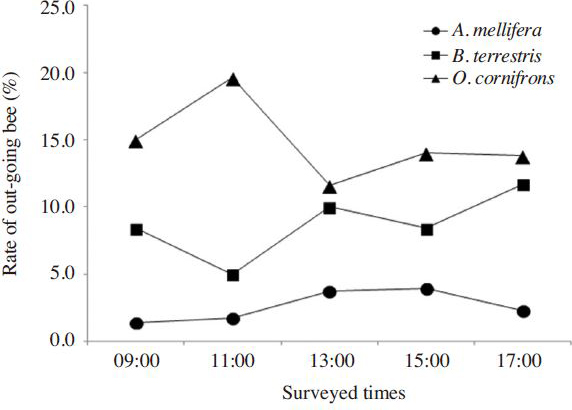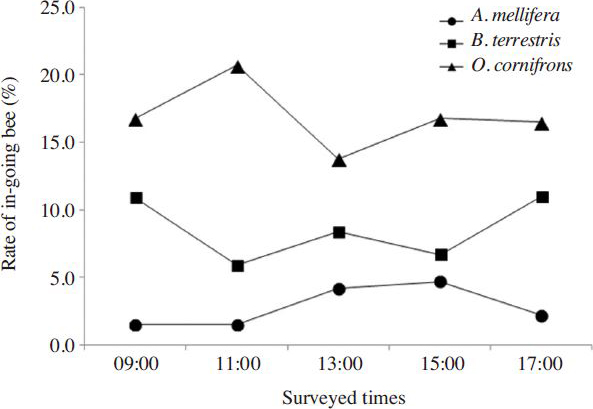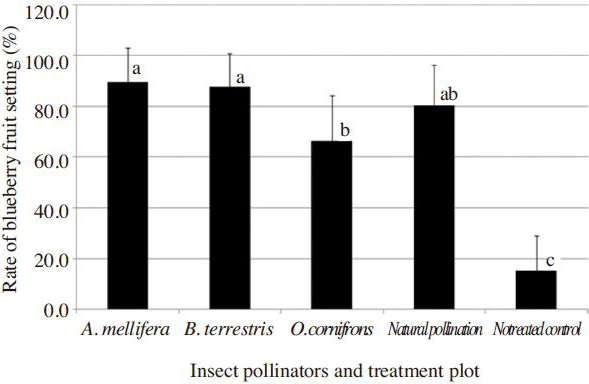
블루베리 듀크 품종에서 화분매개곤충에 의한 수분 특성 및 효과
Abstract
This study was conducted about the 3 species of bee, Apis mellifera, Bombus terrestris, and Osmia cornifrons used for pollination in blueberry "Duke" cultivar field in Pyeongtaek province. Blooming time of blueberry "Duke" cultivar shows always in the middle of the May, and foraging behavior of bees used in this examination showed different tendency each other. Especially the visiting time of B. terrestris was 2.8 sec and the spending time between flower was 2.3 sec, but the visiting time of A. mellifera and O. cornifrons was 6.9 sec and 8.5 sec, respectively. Rate of blueberry fruit setting pollinated with A. mellifera, B. terrestris and O. cornifrons were showed 89.6%, 87.7% and 66.5%, respectively. And, the rate of fruit setting of the untreated control and the control (natural pollination) were 15.4% and 80.3%, respectively. The quality of the products of blueberry fruit pollinated with O. cornifrons showed the highest quality as a result fruit diameter 18.6±0.6mm, fruit weight 2.9±0.3mm, and sugar content by the pollinator A. mellifera was 8.4±1.0 oBrix, the no. of seeds 41.2±12.4. But the economic benefits using the A. mellifera and the B. terrestris compared control were superior to 15% and 9% in contrast to pollinator O. cornifrons in the "Duke" cultivar.
Keywords:
A. mellifera, B. terrestris, O. cornifrons, Pollination, Pollinator, Blueberry, “Duke” cultivar서 론
블루베리는 진달래과(Ericaceae) 산앵도나무속(Vaccinium)의 낙엽성 또는 상록성의 저수고성 또는 반교목성의 과수로, 뉴욕 타임즈가 선정한 세계 10대 장수식품의 하나로 알려져 있다( Park et al., 2015 ). 처음 도입된 해는 1965년경으로 지금도 40년 이상 된 나무들이 있고, 상업적으로 재배되기 시작한 것은 2000년이었다( Song, 2012). 전국 블루베리 재배면적은, 2007년 112ha, 2010년 534ha, 2011년 1,082ha, 2013년에는 재배면적은 1,516ha로 추정하였으며, 총 재배농가수는 4,354농가였다( Kim et al., 2013 ). 특히 2011년 이후부터 블루베리 재배면적이 크게 증가한 것은 블루베리 기능성에 대한 홍보와 소비자의 인식 증가와 더불어 새로운 소득 작물로 농가 수요가 확대되었다( Song, 2012). 2011년에는 국내산 블루베리 가격은 생과 1kg에 40,000~50,000원으로 상당히 비싸게 판매하였지만, 최근에는 블루베리의 국내 생산량이 많아져 가락동시장 거래가격( www.garak.co.kr)은 1kg에 10,000~30,000원 정도의 가격이다.
블루베리 꽃은 꽃밥이 꽃부리 내부에 숨겨져 있고, 꽃가루는 비교적 무겁고 점착성이 있어 뭉쳐진 상태라 바람에 의한 가루받이는 상당히 어려워 방화곤충 활동에 의존해야만 하며, 꿀벌이 대표적인 방화곤충이라고 하였다( Kang et al., 2009 ).
최근 지구온난화와 이상 기후로 인하여 방화곤충의 수도 급격히 줄어들어 양봉 꿀벌에 의존하고 있는 실정이다. 최근에서 이런 이상 환경으로 인하여 시설하우스 재배가 늘어나고 있는 실정으로 화분매개곤충의 활용은 필수적으로 되었다( Yoon et al., 2012 ). 시설 하우스 내에서는 노지와 달리 꽃가루를 날라주는 곤충이 자유롭게 드나들 수 없어 농업인들이 직접 인공적으로 수분을 하여야 하는데 인건비 상승과 농촌 노동력의 고령화로 수분에 어려움을 겪고 있는 실정이다. 이러한 이유로 국내의 시설재배 농가는 꿀벌( Apis mellifera L.), 서양뒤영벌( Bombus terrestris L.) 이나 뿔가위벌류( Osmia spp.)를 이용하여 시설 과채류 및 노지과수를 화분매개를 시키고 있다( Yoon et al., 2009 ).
최근 시설재배작물이 다양화되고 재배면적이 확대되면서 화분매개곤충의 중요성이 부각되고 있는데 화분매개곤충을 이용하면 노동력이 절감되고 수확물의 품질이 개선되기 때문에 그 사용량이 날로 증가하고 있다( Yoon et al., 2008 ).
이에 블루베리에서 화분매개효과 및 특성과 생산물품질조사를 통하여 꿀벌 외에도 서양뒤영벌과 머리뿔가위벌이 화분매개곤충으로 가능한지 여부를 조사하여 블루베리에 적합한 화분매개곤충을 선발하고자 본 연구를 수행하였다.
재료 및 방법
실험 화분매개곤충
블루베리( Vaccinium spp.)는 전국에 가장 많이 재배하는‘듀크’품종을 대상으로 하였으며, 화분매개곤충은 서양종꿀벌( A. mellifera), 서양뒤영벌( B. terrestis)과 머리뿔가위벌( O. cornifrons) 3종을 대상으로 수행하였다. 꿀벌은 1소비(2,000마리) 봉군을 양봉업자에게 구매하여 사용하였고, 서양뒤영벌은 곤충산업과 화분매개곤충 연구실에서 계대 사육한( Yoon et al., 2004 ) 13세대 봉군을 사용하였다. 머리뿔가위벌은 2010년 10월 야외 채집된 머리뿔가위벌 고치를 5°C에서 7개월간 월동시킨 후 2011년 5월 3일부터 25°C에 3일간 보관하여 휴면을 타파시킨 암컷 성충을 사용하였다. 실험구는 꿀벌, 서양뒤영벌, 머리뿔가위벌, 자연수분구, 무처리구 총 5개로 설정하였다. 자연수분구는 기존에 관행적으로 자연계에서 날아오는 방화곤충에 의한 수분이 이루어진 구를 말하며, 무처리구는 임의로 망을 씌워 방화곤충을 차단시켜 자가수분에 의존한 실험구이다. 화분매개곤충별 시험구 배치는 임의 난괴법으로 배치하여 Fig. 1과 같이 설치하였다. 실험 장소는 경기도 평택시 죽백동 소재의 농가 포장을 임대하여 수행하였으며, 벌을 투입한 시기는 개화정도가 70% 진행된 2011년 5월 6일이었다.
화분매개곤충별 화분매개곤충 활동 특성
꿀벌, 서양뒤영벌과 머리뿔가위벌을 대상으로 블루베리“듀크”품종의 화분매개곤충별 활동 특성을 비교 조사하였다. 블루베리 포장에 4.6×4.5m의 망을 9개 설치하여, 수분곤충별로 3반복을 수행하였다. 실험곤충 및 마리수는 소형망에 적합한 적정 밀도로 조정하여 꿀벌은 소비 1장으로 된 일벌 약 2,000마리, 서양뒤영벌은 1봉군 일벌 20마리 내외로 하였으며, 머리뿔가위벌은 암벌 100마리를 사용하였다.
블루베리에서 화분매개곤충별 화분매개활동 특성조사는 벌 투입 후 7일째인 2011년 5월 13일, 10일째인 16일 이틀 동안 오전 9시부터 오후 5시까지 2시간 간격으로 소문출입활동, 방화시간, 꽃 간 이동시간 등을 조사하였다. 소문출입활동은 5분간 출봉수와 입봉수를 조사하여 출봉비율과 입봉비율을 나타내었다. 매회조사 시 하우스 환경 즉 온도, 습도, 조도를 기록한 평균을 Table 1에 나타냈다. 방화시간 및 꽃 간 이동시간은 망실 내에서 각각 30회씩 2회 조사하였다.

The weather conditions per activity time of pollinators in the net screen house in May 13rd and 16 th, 2011
화분매개곤충별 블루베리의 착과율 및 생산물 품질조사
블루베리에서의 화분매개곤충별 착과율을 조사하기 위하여 블루베리의 개화가 70%정도 진행된 2010년 5월 3일에 실험구당 임의로 30개씩 라벨링을 하여 블루베리에서 꽃수를 조사한 후 약 40일 후인 2010년 6월 8일에 착과된 열매의 수를 조사하여 착과율로 나타내었다. 블루베리의 수분곤충별 생산물 품질 조사를 위하여 블루베리 열매의 장경과 단경의 과경, 과중, 당도와 종자수를 조사하였다. 장경은 열매의 좌우폭, 단경은 열매의 위아래 폭을 디지털 calculator(Mitutoyo corp. CD-15CP, Japan)를 사용하여 측정하였으며, 과중은 열매의 무게를 저울(A&D company, FX-3000i, Korea)로 측정하였다. 종자수는 블루베리의 열매를 이룬 낱개 과를 분리하여 수를 세었으며, 당도는 디지털 refractometer(ATAGO, PR-32α)를 이용하여 측정하였다. 생산물 품질 조사는 실험구당 30개씩을 대상으로 조사하였다.
통계분석
수분곤충별 착과율과 생산물 품질에 대한 화분매개효과 및 방화특성 등 통계분석은 일원배치 분산분석(One-way ANOVA test)과 welch's ANOVA으로 분석하고, ANOVA test를 거친 모든 데이터는 Tukey HSD로 사후검정을 하였다. 수행된 모든 통계분석은 SPSS PASW 18.0 for windows 통계 패키지 프로그램(IBM, USA)을 사용하였다.
결과 및 고찰
블루베리에서 화분매개곤충별 방화활동 비교
블루베리 망실 내에서 화분매개곤충별 방화활동 특성을 조사하기 위하여 화분매개곤충 방사 1주일 후인 2013년 5월 13일과 16일 이틀 동안 오전 9시부터 2시간 간격으로 17시까지 화분매개특성을 조사하였다. 조사당시의 기상환경은 Table 1에 나타난 것처럼 온도는 20.5~24.0°C, 습도 34.5~55.5%, 조도 36,050~73,100 lux이었으며, 풍속은 1.0~2.0m/s였다. 화분매개 곤충별로 방화시간 및 꽃 간 이동시간을 Table 2에 나타내었다. 방화시간은 꿀벌 6.9±3.5초, 서양뒤영벌 2.8±1.3초, 머리뿔가위벌 8.5±6.7초로서 서양뒤영벌이 방화시간이 가장 짧았으며, 꿀벌에 비해 3배, 머리뿔가위벌에 비해 4배정도 짧은 것으로 통계적으로 고도의 유의성이 있는 것으로 나타났다(Oneway-ANOVA test: F=72.89, df=2, p=0.0001). 화분매개곤충별 꽃 간 이동시간에 있어서는 꿀벌 3.1±2.0초, 서양뒤영벌이 2.3±1.6초, 머리뿔가위벌 4.4±2.6초로서 화분매개곤충별 차이가 거의 없었으며, 통계적으로도 유의성이 있는 것으로 나타났다(F=39.17, df=2, p=0.0001). 서양뒤영벌의 경우, 딸기꽃에서는 방화시간은 5.1초, 꽃 간 이동시간은 3.7초( Lee et al., 2008 )이었고, 시설방울토마토에서는 방화시간은 5.2초, 꽃 간 이동시간은 3.6초( Lee et al., 2004 ), 복분자딸기에서 방화하는 시간은 각각 2.7초, 꽃 간 이동시간은 2.6초( Kim et al., 2013 )로 보고하였는데, 블루베리의 꽃에서의 방화특성은 방울토마토와 딸기의 방화시간에 비해 2배정도 짧고, 복분자딸기와는 비슷한 경향을 보였다. 꿀벌의 경우에 복분자딸기에서의 방화시간은 3.1초, 꽃 간 이동시간은 2.8초( Kim et al., 2013 )인데 비해 블루베리에서의 방화시간은 2배 이상 길었던 것으로 나타났다. 블루베리 꽃은 종모양으로 꽃부리의 선단이 좁아지고, 암술대가 꽃부리보다도 길게 돌출되어 있고, 꽃가루는 비교적 무겁고 점착성이 있어 뭉쳐진 상태이다( Park et al., 2015 ). 이러한 블루베리 꽃의 화기구조에 의해 몸 크기가 서양뒤영벌에 비해 작은 꿀벌과 머리뿔가위벌의 방화시간이 길었던 것으로 판단된다.
화분매개곤충별 활동특성을 조사한 결과, 시간대별 출봉비율은( Fig. 2), 오전 9시에는 꿀벌 1.4%, 서양뒤영벌 8.4%, 머리뿔가위벌 15.0%로 수분곤충별 통계적 고도의 유의적 차이는 있었으며(Oneway-ANOVA: F=23.36, df=2, p=0.0001), 머리뿔가위벌의 출봉비율이 가장 높게 나타났다. 11시에는 꿀벌 1.7%, 서양뒤영벌 5.0%, 머리뿔가위벌 19.6%로서 머리뿔가위벌이 가장 높은 출봉비율이 보였으나, 역시 통계적 유의성이 있었다(F=11.04, df=2, p=0.001). 13시에는 꿀벌 3.7%, 서양뒤영벌 10.0%, 머리뿔가위벌 11.6%로 머리뿔가위벌, 서양뒤영벌, 꿀벌 순으로 출봉비율을 나타냈으며, 통계적 유의성은 없었다(F=4.56, df=2, p=0.028). 15시에는 꿀벌 3.9%, 서양뒤영벌 8.4%, 머리뿔가위벌 14.0%의 출봉비율을 보였으며, 수분곤충별 큰 차이를 보이지는 않았다(F=5.02, df=2, p=0.021). 17시의 출봉비율의 경우 꿀벌은 2.3%, 서양뒤영벌 11.7%, 머리뿔가위벌 13.8%였으며, 역시 머리뿔가위벌이 가장 높게 나타났으며 수분곤충별 유의성을 나타냈다(F=11.15, df=2, p=0.001). 꿀벌은 온도 24.0°C, 습도 34.5%, 조도 73,100 lux의 15시에 가장 높은 출봉비율을 나타냈으며, 서양뒤영벌의 경우 온도 22.0°C, 습도 50.0%, 조도 36,050 lux인 17시에 출봉비율이 11.7%이었으며, 머리뿔가위벌은 온도 22.5°C, 습도 47.5%, 조도 69,350 lux의 11시에 19.6%로 높게 나타났다. 서양뒤영벌은 낮은 온도와 조도에서도 활동이 활발함을 보여주고 있다.

Rate of out-going bees among A. mellifera, B. terrestris and O. cornifrons in the net screen house of blueberry field. The rate of out-going bee of insect pollinators was investigated 9:00 to 17:00 at intervals of two hours for two days. Survey of 9:00, 11:00 and 17:00 time was statistically significant ( p<0.05, Oneway-ANOVA test), the rest of the survey times were not significant.
입봉비율을 조사한 결과( Fig. 3), 9시대에는 꿀벌 1.5%, 서양뒤영벌 10.9%, 머리뿔가위벌 16.8%로 머리뿔가위벌이 높았으나 수분곤충별 고도의 유의성을 나타냈다(Oneway-ANOVA test: F=19.80, df=2, p=0.0001). 11시에는 꿀벌 1.5%, 서양뒤영벌 5.9%, 머리뿔가위벌 20.7% 였으며, 머리뿔가위벌이 가장 높게 나타났으며, 역시 수분곤충별 유의적 차이가 있었다(F=4.59, df=2, p=0.001). 13시의 경우 꿀벌 4.2%, 서양뒤영벌 8.4%, 머리뿔가위벌 13.8%로 수분곤충별 통계적 유의성은 없었으며(F=3.08, df=2, p=0.076), 15시에는 꿀벌 4.7%, 서양뒤영벌 6.7%, 머리뿔가위벌 16.8%로 수분곤충별 통계적 유의성은 없었다(F=6.36, df=2, p=0.010). 17시 입봉비율은 꿀벌 2.2%, 서양뒤영벌 11.0%, 머리뿔가위벌 16.5%였으며, 수분곤충별 유의적 차이를 나타냈다(F=10.51, df=2, p=0.001). 꿀벌의 입봉비율은 15시, 서양뒤영벌은 17시, 머리뿔가위벌의 경우에는 11시에 입봉비율이 가장 높게 나타났다.
이와 같이 출봉비율과 입봉비율을 분석한 결과, 꿀벌의 경우에는 15시에 소문출입활동이 가장 활발하였으며, Kang 등(2009)은 복분자 딸기에서 꿀벌의 일주활동이 19°C인 오전 9시에 가장 활발하였다고 한 결과와는 다른 결과를 보였다. 서양뒤영벌의 경우에는 17시에 가장 활발한 소문출입활동을 하는 것을 보였고, 머리뿔가위벌은 11시에 높은 출봉비율과 입봉비율을 나타냈는데, Lee 등(2008)에 딸기에서 서양뒤영벌의 출입봉 비율이 15시 경에 가장 활발하였다고 한 결과와 또한 다른 결과를 보였으나, 이런 결과는 기상환경에 따른 차이라고 판단된다.

Rate of in-coming bees among A. mellifera, B. terrestris and O. cornifrons in the net screen house of blueberry field. The rate of in-coming bee of insect pollinators was investigated 9:00 to 17:00 at intervals of two hours for two days. Survey of 9:00, 11:00 and 17:00 time was statistically significant ( p<0.05, Oneway-ANOVA test), the rest of the survey times were not significant.
화분매개곤충별 착과율 및 생산물 품질 조사
블루베리에서 화분매개곤충별 화분매개곤충의 효과를 보기 위해 블루베리의 착과율을 조사한 결과( Fig. 4), 꿀벌이 89.6%로 가장 높았고, 그 다음이 서양뒤영벌이 87.7% 자연수분구 80.3%, 머리뿔가위벌 66.5% 순이었으며, 무처리구는 15.4%로 가장 낮았다. 화분매개곤충별 착과율은 유의성이 확인되었다(Oneway-ANOVA test: F=4.82 df=4, p=0.001). 꿀벌의 착과율은 무처리구와 대비하여 74.2%나 높았으며, 자연수분구 대비하여 9.3%정도 높게 나타났다. 서양뒤영벌의 착과율은 무처리구와 대비하여 72.3% 높았다. 머리뿔가위벌의 착과율은 자연수분구 대비하여 더 낮았다. 무처리구 착과율이 매우 낮게 나타난 것으로 보아 블루베리는 방화곤충의 영향을 많이 받는 것으로 판단된다.

Rate of blueberry fruit setting among A. mellifera, B. terrestris and O. cornifrons in the net screen house of blueberry field. Rate of blueberry fruit setting was investigated no. of 60 of insect pollinators. Rate of blueberry fruit setting was not differed significantly among insect pollinators ( p>0.05, one-way ANOVA) and differed significantly between pollinators and untreated control ( p<0.05, welch's ANOVA).
화분매개곤충별 블루베리의 생산물 조사 결과를 Table 3에 나타내었다. 블루베리의 과경에 있어서 장경과 단경을 조사하였는데, 장경은 꿀벌 투입구는 18.2±0.7mm, 서양뒤영벌은 18.1±0.7mm, 머리뿔가위벌은 18.6±0.6mm, 자연수분구 18.2±0.5mm, 무처리구는 13.0±1.2mm였으며 머리뿔가위벌 투입구가 가장 장경이 높게 나타났으며, 처리구에 있어서 통계적으로도 고도의 유의성이 있는 것으로 확인하였다(Oneway-ANOVA test: F=6.15, df=4, p=0.0001). 단경에 있어서는 꿀벌은 13.0±0.5mm, 서양뒤영벌 13.0±0.6mm, 머리뿔가위벌은 13.0±0.5mm, 자연수분구 12.6±0.5mm, 무처리구 12.9±1.1mm로 모든 처리구에서 비슷하게 나타났으며, 통계적으로 유의한 것으로 나타났다(F=10.37, df=4, p=0.0001). 과중의 경우 꿀벌은 2.8±0.3g, 서양뒤영벌 2.7±0.3g, 머리뿔가위벌 2.9±0.3g, 자연수분구 2.7±0.2g, 무처리구는 1.2±0.3g으로 과중에 있어서는 꿀벌이 가장 높게 나타났다. 이 또한 통계적 유의성이 없었다(F=1.46, df=4, p=0.215). 꿀벌에 의해 수정된 과실의 당도는 8.4±1.0 oBrix였으며, 서양뒤영벌은 8.0±0.8 oBrix, 머리뿔가위벌 8.3±1.2 oBrix, 자연수분구 8.6±1.0 oBrix, 무처리구 8.9±1.1 oBrix를 나타냈으며, 당도에 있어서도 모든 처리구가 비슷하게 나타났으며 유의성이 없음을 확인하였다(F=1.69, df=4, p=0.152). 종자수는 꿀벌 41.2±12.4개, 서양뒤영벌 38.7±13.7개, 머리뿔가위벌 36.3±12.1개, 자연수분구 43.8±12.1개, 무처리구는 30.8±9.5개를 나타냈으며, 종자수에 있어서 자연수분구와 꿀벌이 가장 높게 나타났으며, 통계적으로도 유의성이 없음을 확인했다(F=1.52, df=4, p=0.195). 이상의 착과율 및 생산물 품질 조사의 결과로 볼 때 모든 처리구에서 비슷하게 나타났다.
생산물 품질의 과중의 결과로 경제성 분석을 해본 결과( Table 4), 자연수분구 대비 꿀벌은 115, 서양뒤영벌은 109의 경제성 지수를 나타냈으며, 방화활동이 가장 높았던 머리뿔가위벌은 87로 자연수분구에 비해 낮은 경제적 지수를 보였다. 이와 같이 착과율과 생산물품질조사 및 경제성 분석을 고려해 보았을 때 블루베리 듀크 품종에서 화분매개용으로 사용하기에 꿀벌과 서양뒤영벌이 적합한 것으로 판단된다.
적 요
국내에서는 블루베리의 수분을 위해 꿀벌을 방화곤충으로 주로 사용하고 있으나, 이상기온과 환경에 의해 꿀벌은 수분활동에 영향을 많이 받는다. 이에 블루베리에 적합한 수분곤충을 선발하기 위하여 꿀벌, 서양뒤영벌, 머리뿔가위벌 3종에 대해서 방화활동 특성을 조사한 결과, 꿀벌의 출봉비율은 15시에 3.9%, 입봉비율은 4.7.0%이었으며, 서양뒤영벌은 17시에 출봉비율 11.7%, 입봉비율 11.0%이었고, 머리뿔가위벌의 경우 11시에 출봉비율 19.6%, 입봉비율 20.7%로 출입활동이 가장 활발하였다. 화분매개곤충별 방화시간 및 꽃간 이동시간은 서양뒤영벌은 각각 2.8초, 2.3초였으며, 꿀벌은 각각 6.9초, 3.1초, 머리뿔가위벌은 각각 8.5초와 4.4초 였다. 또한 화분매개곤충별 착과율의 경우 꿀벌 89.6%, 서양뒤영벌 87.7%, 머리뿔가위벌 66.5%, 자연수분구는 80.3%, 무처리는 15.4%를 나타냈으며, 꿀벌과 서양뒤영벌의 경우에 가장 높게 나타났다. 화분매개곤충을 이용한 블루베리의 생산물 품질에 있어서 꿀벌의 경우에 장경 18.2mm, 단경 13.0mm, 과중 2.8g, 당도 8.4 oBrix, 종자수 41.2개로 다른 수분곤충과도 비슷하게 나타났지만, 경제적 분석결과 꿀벌은 15%, 서양뒤영벌은 9% 소득향상을 예상할 수 있었다. 이런 결과로 볼 때 블루베리 수분을 위해서는 꿀벌과 함께 서양뒤영벌도 적합한 것으로 판단된다.
감사의 글
본 연구는 농촌진흥청 국립농업과학원 농업과학기술 연구개발사업(과제번호: PJ01084001)의 지원에 의해 이루어진 것입니다.
인용문헌
- Ahn, S.B., I.S. Kim, W.S. Cho, and K.M. Choi, (1989), Survey on the present situation of honeybee use as the pollinator in the plastic house of strawberry cultivation area by the questionnaire, Korean J. Apiculture, 4, p1-8.
- Albano, S., E. Salvado, and J. Cadima, (2000), General pattern of bumblebee visits to tomato flowers in greenhouse condition, Abstract book I. XXI-International Congress of Entomology, Brazil, August 20-26, p298.
-
Banda, H.J., and R.J. Paxton, (1991), Pollination greenhouse tomatoes by bees, Acta Horticulturae 288. 6th Pollination Symposium, p204-212.
[https://doi.org/10.17660/ActaHortic.1991.288.28]

- Free, J.B., (1970), Insect pollination of crops, Academic Press, New York, p544.
-
Gallai, N., S. Jean-Michel, S. Josef, and V. Bernard E., (2009), Economic valuation of the vulnerability of world agriculture confronted with pollinator decline, Ecol. Eco, 68, p810-821.
[https://doi.org/10.1016/j.ecolecon.2008.06.014]

- Heinrich, B., (1979), Bumblebee economics, Harvard University Press, Cambridge, Massachusetts, and London, England, p207-213.
- Kang, K.H., D.Y. Moon, K.C. Sung, S.C. Kim, C.W. Kim, E.Y. Song, K.C. Jang, J.S. Lee, and N.Y. No, RDA, Korea, (2008), Blueberry, p255.
- Kang, M.S., J.K. Han, S.H. Kim, K.Y. Lee, and U.S. Paik, (2009), Effects of Pollinators on the Fruit Production of Korean Black Raspberry, Korean J. Apiculture, 24(3), p153-158.
- Kim, M.A., H.J. Yoon, I.G. Park, K.Y. Lee, and Y.M. Kim, (2013), Effect of Insect Pollinators for Korean Raspberry ( Rubus coreanus MIQ.) in the Green House , Korean J. Apiculture, 28(5), p323-330.
- Kim, S.J., K.S. Park, S.J. Park, and Y.H. Kwon, (2013), Current Status of Blueberry Culture in Korea, Korean Society For Horticultural Science, 31, p139.
- Kim, Y.S., S.B. Lee, Y.S. Jo, M.L. Lee, H.J. Yoon, M.Y. Lee, and S.H. Nam, (2005), The comparison of pollinating effects between honeybee ( Apis mellifera) and Bumblebee ( Bombus terrestris) on the kiwifruit raised in greenhouse , Korean J. Apiculture, 20, p47-52.
- Lee, K.Y., H.J. Yoon, I.G. Park, M.A. Kim, Y.M. Kim, and P.D. Kang, (2012), Selection of insect pollinators for selfing cages for welsh onion ( Allium fistulosum L.) seed production , Korean J. Apiculture, 27, p283-291.
- Lee, S.B., H.S. Sim, H.J. Yoon, N.G. Ha, S.R. Kim, I.H. Park, and Y.D. Lee, (2006), The effect of the side wall net attached for the efficient use of Bombus terrestris hive in the cherry-tomato houses , Korean J. of Apiculture, 21, p131-138.
- Lee, S.B., N.K. Ha, K.Y. Lee, H.J. Yoon, I.G. Park, H.S. Kang, S.J. Hwang, M.Y. Lee, and K. Choi, (2008), Characteristics and Effects on the Pollinating Activities of Honeybee, Apis mellifera L. and White-tailed Bumblebee, Bombus terrestris L. (Hymenoptera: Apidae) in Strawberry Vinyl Houses , Korean J. of Apiculture, 23, p73-81.
- Lee, S.B., S.E. Kim, M.R. Lee, H.J. Yoon, I.K. Park, J.W. Kim, and T.W. Bae, (2001), Compare with foraging activities of Bombus ignitus and B. terrestris in cherry-tomato cultivating house , Korean J. of Apiculture, 16, p90-98.
- Lee, S.B., S.H. Sik, Y.S. Kim, H.J. Yoon, S.E. Kim, J.W. Kim, N.G. Ha, and S.R. Kim, (2004), The comparison of forage add activity and life span of Bombus ignitus and B. terrestris in the cherry-tomato house , Korean J. Apiculture, 19, p27-26.
- Park, K.S., S.J. Kim, E.H. Jang, M.S. Ryu, H.Y. Joo, S.W. Go, S.C. Lee, T.J. Kang, D.J. Ha, D.S. Jeong, K.C. Seong, H.L. Kim, and Y.H. Kwon, (2015), Blueberry, Agricultural Technology Guidance, p246.
- Ravestijn, W. van., and J. van der Sande, (1991), Use of bumblebee for the pollination of greenhouse tomatoes, Acta Horticulturae 288. 6th Pollination Symposium, p204-212.
- Rural Development Administration (RDA), (2006), Welsh onion culture (Standard textbook for farming), p40-41, RDA Press, Suwon, Korea.
- Shimotori, K., (1981), Honeybees and strawberry industry in Tochigi, Honeybee Sci, 2, p57-60.
- Song, G.C., (2012), The Cultural Status and the Industrial Prospects on Blueberr, Korean Society of Plant Biologists, p9.
- SPSS PASW ® Statistics 18.0 , (2007), PASW ® Core System User’s Guide , SPSS inc, USA.
- Statistics Korea, (2011), Crops production statistics, p21-22, Statistics Korea Press, Korea.
- Sutcliffe, G.H., and R.C. Plowright, (1990), The effects of pollen availability on development time of the bumblebee. Bombus terricola K. (Hymenoptera: Apidae) , Can. J. Zool, 68, p1120-1123.
- Velthuis, H.H. W., and L. Cobb, (1991), Pollination of Primula in a greenhouse using bumblebee , Acta Horticulturae 288. 6th Pollination Symposium, p199-203.
- Wata, T., (1993), Pollination of fruit vegetables and fruit by bumblebee in greenhouses, Farming Japan, 27, p38-43.
- Yoon, H.J., I.G. Park, K.Y. Lee, M.A. Kim, and P.D. Kang, (2012), Bumblebee Rearing Technology Manual, National Academy of Agricultural Science, RDA, p165.
- Yoon, H.J., K.Y. Lee, I.G. Park, M.A. Kim, Y.M. Kim, and P.D. Kang, (2013), Characteristics on Pollinating Activity of Bombus terrestris and Osmia cornifrons under Different Weather conditions at Apple Orchard , Korean J. Apiculture, 28, p163-171.
- Yoon, H.J., K.Y. Lee, M.A. Kim, I.G. Park, and Y.C. Choi, (2011), Current Status of Insect pollinator use in strawberry crop in Korea, Korean J. Apiculture, 26, p143-155.
- Yoon, H.J., K.Y. Lee, S.B. Lee, I.G. Park, S.J. Jang, Y.C. Choi, Y.S. Choi, and G.G. Lee, (2008), Research on the current status of insect pollinator use in Korea. NAAS, RDA, Korea, Korean J. Apiculture, 23, p295-304.
- Yoon, H.J., S.B. Lee, I.G. Park, K.Y. Lee, M.A. Kim, and Y.C. Choi, NAAS, RDA, Korea, (2009), Bumblebee rearing technology for crop pollination, p113.
- Yoon, H.J., S.E. Kim, Y.S. Kim, and S.B. Lee, (2004), Colony developmental characteristics of the bumblebee queen, Bombus ignitus by the First oviposition day , Int. J. Indust. Entomol, 8, p139-143.
- Yuk, C.S., (1990), Coloured medicinal plants of Korea, Academy Publishing Co., Ltd, p275.
